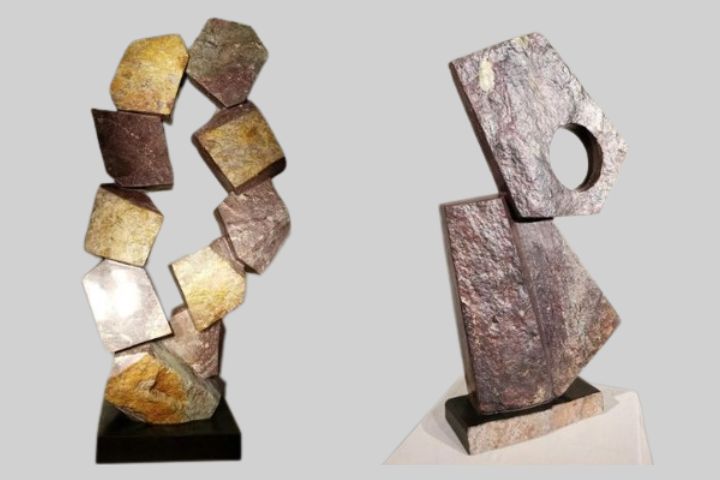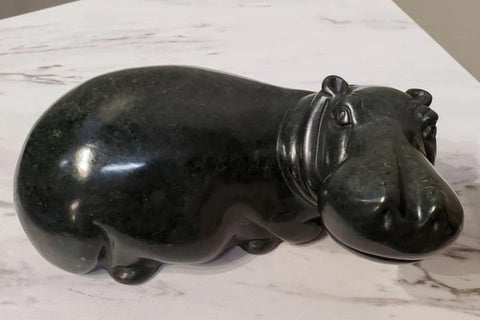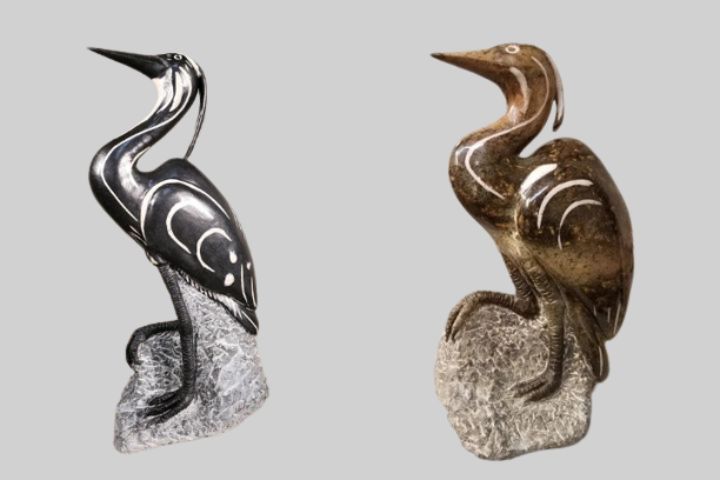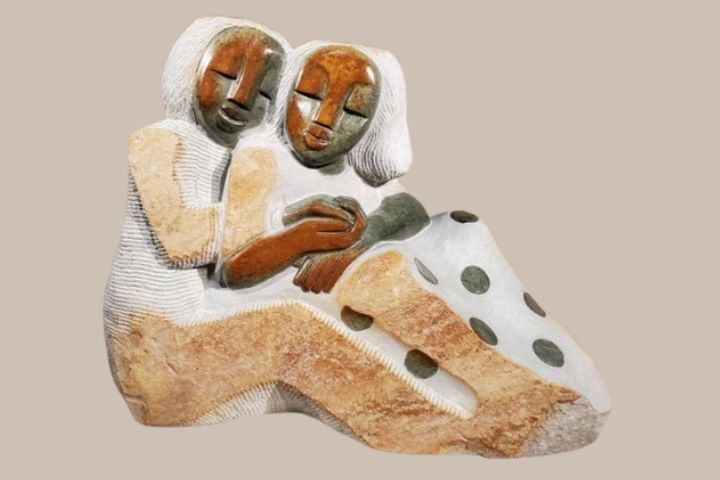When you think of Zimbabwe, images of lush landscapes and diverse wildlife might come to mind. However, hidden beneath its surface lies a geological wonder that has played a crucial role in the country's artistic heritage – the Great Dyke. Stretching over 310 miles from the north to the south of Zimbabwe, this 2.5 billion-year-old ridge is the world's longest linear mass of volcanic rock.
The Great Dyke: A Ridge of Riches

Great Dyke of Zimbabwe
The Great Dyke is adorned with deposits of chrome, platinum, gold, copper, emeralds, and other precious metals and minerals, formed over millennia due to forces of heat and pressure. While it was once believed to harbor the fabled wealth of Ophir, the Great Dyke did not yield the envisioned mountains of gold. Instead, it has blessed the region with a bountiful supply of carving stones.
Stone Variety: Nature's Palette
In different areas along the ridge of the Great Dyke, you can find specific types of stones distinguished by their captivating colors and varying hardnesses. To measure the relative hardness of minerals, we use the Mohs Hardness Scale, which German chemist and mineralogist Friedrich Mohs developed in 1812. The scale ranges from 1 to 10. Talc is the softest naturally occurring mineral and is typically rated 1 on the scale, while diamond, being the hardest, is a 10.
Serpentine Stones
Zimbabwean sculpture predominantly features stones from serpentine formations, containing a blend of minerals, including quartz, chromium, manganese, copper, and iron. The name derives from the striking resemblance between the stone's texture and patterns to a serpent's skin. Serpentine stones exhibit a range of colors, including yellow, green, brown, and black.
Each stone possesses a distinct appearance, shaped by the unique patterns of mineral inclusions, with ratings ranging from 2 to 7 on the Mohs Hardness Scale. Each type has a local name that reflects the inherent beauty and properties of the material. Experienced sculptors often select the hardest serpentine varieties, including Springstone, Fruit Serpentine, and Leopard Rock.
Springstone
This stone can attain a deep black luster reminiscent of black opal. The beautiful black shine emerges when polished with floor wax. Mined in a northern Zimbabwean region known as Guruve, springstone stands out as one of the darkest and most durable stones, with hardness ratings of 5 - 7 on the Mohs Scale.
When first-generation sculptor John Takawira first worked with springstone, the hard rock caused his chisel to spring off its surface, inspiring the name "springstone." Its hardness, durability, and exceptional finish make springstone popular among sculpture enthusiasts.

The stone sculpture "Regal," depicting a realistic stallion, was carved from springstone by Zimbabwean artist Taurai Maisiri
Most of the sculptures for sale in the Meyavé art gallery, including this regal horse by Taurai Maisiri, were carved from springstone.
Opalstone
Artists value opalstone for its glossy, translucent-like finish and consistent texture, which has fewer color variations than other types of serpentines. It is a hard stone, rated 5.0 to 5.5 on the Mohs Hardness Scale. Among the most coveted opalstones is the green opalstone or Chiweshe serpentine, discovered during the late 1980s in the Zimbabwean district of Chiweshe. While its primary hue is vibrant green, the stone exhibits a diverse spectrum, including milky light green, fiery reds, orange with iron deposits, deep blacks, shades of brown, and occasional mottling in red, orange, or bluish patterns.
Zimbabwean artist Vernon Nyagweta's sculpture, "Unforgettable Moments of Love," carved from green opalstone.
Cobalt
The serpentine variation called 'cobalt' is named for its distinct colors, often characterized by a purplish-greenish hue with yellow and white striations. While its name suggests a connection to the metallic element, it's purely descriptive of the stone's appearance and contains no actual cobalt. Mined predominantly in Guruve, Zimbabwe, cobalt serpentine ranks 5 to 6 on the Mohs Hardness Scale.

Zimbabwean artist Bywell Sango's stone sculptures, "Building Blocks of Life" (left), and "Balanced Silhouette" (right), which be carved from the serpentine variety known as cobalt
Fruit Serpentine Stone
Fruit serpentine, also known as Kwekwe serpentine, is found in the Kwekwe area, located roughly 130 miles southwest of Harare. This serpentine variety is distinguished by its multi-colored appearance, featuring deep veins of varied strata. On the Mohs Hardness Scale, fruit serpentine ranks between 4 and 5.

Zimbabwean artist Shingi Chatsama's stone sculpture, "Lounging Hippo," made from fruit serpentine stone
Leopard Rock
Scientifically known as dunite, leopard rock earned its colloquial name thanks to its uncanny resemblance to a leopard's coat. It contains mesmerizing spots of yellow and black olivine, a mineral composed of magnesium, iron, and silicate. You can find deposits of leopard rock in Ruwa, near Harare, and a few smaller mines in Nyanga, in the Eastern Highlands near the Mozambique border. Its hardness falls within the range of 6.0 to 7.0 on the Mohs Scale. Considering how difficult it is to carve, typically only highly skilled sculptors take up the challenge.
Non-Serpentine Stones
Stones not in the serpentine geological family are less commonly used in sculpting. Some non-serpentine stones, like soapstone, are less durable than serpentine rocks, while others, like verdite, are more difficult to find.
Granite
In its unpolished state, granite often exhibits a coarse, textured surface with diverse colors, including whites, grays, pinks, and blacks. It can achieve a glossy polished finish, highlighting its natural patterns and colors. However, granite is not commonly used in Zimbabwean sculpture due to its extreme hardness, typically ranking 6 to 7 on the Mohs Hardness Scale. Its hardness makes it challenging to carve, especially for intricate designs. Instead, granite is primarily valued and utilized for architectural purposes, such as construction materials for buildings and monuments.
Soapstone
In contrast, soapstone, named for its tactile resemblance to soap due to its high talc content, exhibits a relatively softer nature. Talc has a value of 1 on the Mohs Hardness Scale. The hardness of soapstone can vary widely, primarily based on its talc content. Soapstone is less suitable for designs that demand more durability. Instead, it is highly valued for its heat-retaining properties and is predominantly used for crafting functional items like cooking pots and bowls.
Dolomite
Dolomite is a sedimentary rock composed primarily of calcium, magnesium, and carbonate. Dolomite typically appears white, gray, or pinkish in its raw form. When carved and polished, it can achieve a smooth, light sheen. Dolomite's hardness rating varies depending on its composition but generally falls between 3.5 and 4 on the Mohs Hardness Scale, which is relatively soft compared to other stone types used for sculpture. While it may not be as common as serpentine, some sculptors still like it for its unique qualities and appearance.

Shephard Deve's stone sculptures, "Black Heron" (left) and "Brown Heron" (right), made from serpentine stone with white dolomite inlay
Verdite
Renowned for its striking colors, ranging from golden browns to rich emerald greens and blues, this semi-precious stone is found exclusively in Zimbabwe and South Africa. Zimbabwean verdite is unique as it contains inclusions of ruby corundum, a mineral ranking remarkably high at 7.0 to 9.0 on the Mohs Hardness Scale, second only to diamond. Verdite, nicknamed "Green Gold" due to its ruby corundum content, is challenging to carve and demands exceptional sculpting skills. As this stone becomes increasingly difficult to find, the demand and value of verdite sculptures will increase.
In our next blog post, we'll explore the innovative mining process responsible for bringing these unique stones into the hands of skilled sculptors. Stay tuned for more on this fascinating subject.
Which carving stones do you like the most? I'd love to hear your thoughts and questions in the comments below.

